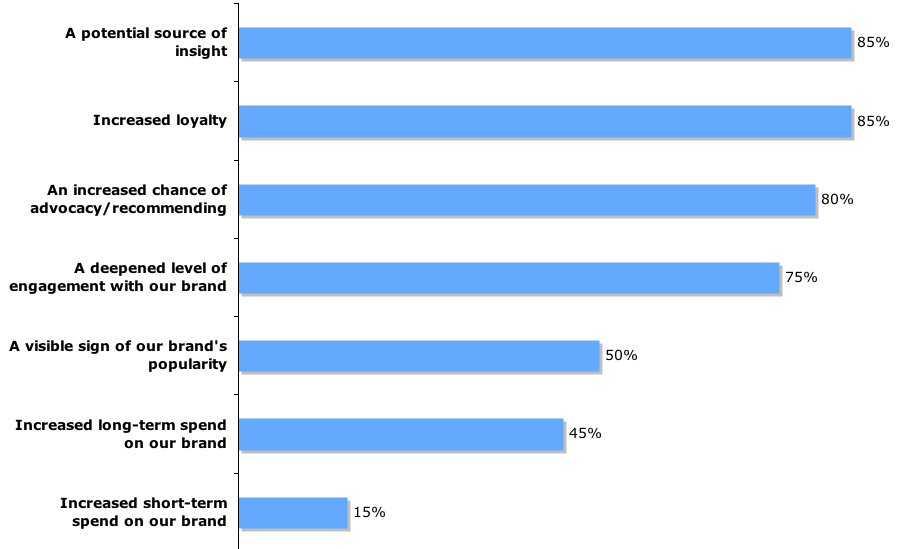As communicators continue to get whipped into a Facebook frenzy, there’s been little research into what drives people to become fans of brands, and what drives Facebook’s value for communicators. But a recent study by Millward Brown and Dynamic Logic in cooperation with the World Federation of Advertisers (WFA) delves into the world of fans and brands, identifying what global marketers expect from social media and what drives most value for both groups.
Among the findings, “Value of a Fan” identifies the perceived value that social media delivers for communicators. Of the respondents, 85% regard fan pages as a means of securing additional insight and increasing loyalty, while 80% cited the opportunity to increase advocacy (see chart). These values are similar to how Frank Eliason, SVP of social media at Citi, views them. “I have always viewed social media as an opportunity to increase loyalty and advocacy by engaging with customers and listening to their needs,” says Eliason, who will be a speaker at PR News ’ May 24 Facebook Conference in New York.
Idil Cakim, senior VP of interactive media at PR agency GolinHarris, suggests an additional benefit for communicators that takes engagement with fans deeper. “Fans who come across a Facebook promotion can visit a product site or attend an offline event,” says Cakim (also set to be a speaker at the Facebook Conference). “So, I would add increased participation in related online/offline promotions.”
 |
| A survey of communicators from 24 multinational companies identified ways in which they valued their brands’ Facebook fans. Gaining insight, loyalty and deepened engagement were tops on the list. Source: Millward Brown/Dynamic Logic |
FACEBOOK ROI
The much-discussed topic of achieving ROI with Facebook is also explored in the study, with 50% of respondents unsure of their return on investment, 23% saying they were getting a good return and 27% regarding payback as just average or poor.
Cakim says ROI can be measured on Facebook through the impact of Facebook activities on business goals. “The size of the community is not the only value metric and does not necessarily mean that every single member of the community is involved with the brand,” says Cakim.
Eliason has a slightly different take: “Typically I only hear the ROI question from marketers,” he says. “Many times I hear PR people talk about sentiment.” The key to achieving ROI for Facebook, he says, is to first partner with all businesses units impacted by your social efforts, determine your collective goals and understand what the needs of your customer is and why.
The study also identifies five basic expectations from fans, which apply to all brand pages, and five proposed differentiators, which can help pages stand out but may not all be appropriate to all brands.
The five basic expectations identified in the report are regular posts, trustworthy brand news, new product information, contests and special offers.
Cakim says she was curious to know more about how fans selected the five health indicators. “It made me wonder if we’re shaping audiences’ expectations from this medium by running contests and sweepstakes to expand communities,” she says. “Savvy users know to complain about a brand on Twitter to get attention or resolution. What about long-term relations on Facebook? Are consumers thinking this way?”
Certainly food for thought, and here’s hoping that future studies will explore such queries. PRN
[Editor’s Note: Hear more insights from Cakim and Eliason at PR News’ May 24 Facebook Conference. To register go to prnewsonline.com/conferences/facebookconference2011.html.]
CONTACT:
Frank Eliason, [email protected]; Idil Cakim, [email protected].
